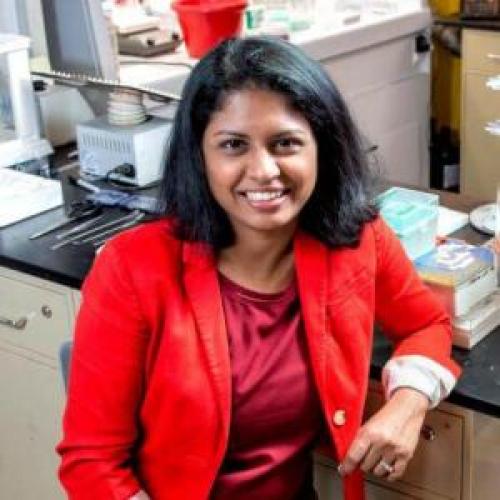Research
Funding
NSF
Group Information
Research Directions of the Biomolecular Assemblies and Nanomechanics Lab
- Biophysics of glycans
- DNA nanocontainers for multiplexed delivery
- Multi-scale bio-mechanics modeling; Computational platform for modeling filamentous architectures with high fidelity to microstructural physics (nonlinear bending/hydrodynamic/ charge /crosslink/Brownian interactions) for investigating resilience, fracture, and collapse in cytoskeletal to man-made structures.
- Biomolecular interactions in cartilage injuries
- Comprehensive integrated soft-biomaterial characterization suite including Atomic Force Microscopy, Rheology, Dynamic Light Scattering, Nanoindentation, Modeling, and analysis software for multiple signal deconvolution
Publications
- Abeyratne-Perera H, Basu S, Chandran PL, Multiplexing delivery of proteins in DNA containers, Material Sciences and Engineering C (2021), 127, 112184
- Ogharandukun E, Teowolde W, Damtae E, Wang S, Ivanov A, Kumari N, Nekhai S, Chandran PL, Establishing rules for self- adhesion and aggregation of N-glycan sugars using virus glycan shields, Langmuir, (2020), 36, 46, 13769–13783
- Chandran PL, Sequential Extraction of Late Exponentials (SELE): A technique for deconvolving multimodal correlation curves in Dynamic Light Scattering, MRS Advances, 5(17), 865-880. doi:10.1557/adv.2020.163
- Simhadhri J, Chandran PL, ‘Capturing 3D large-strain Euler-bending filament dynamics in fibrous media simulations; sample case of compression collapse in dendritic actin network’, Scientific Reports (2019), DOI: 10.1038/s41598-019-40430-y
- Abeyratne-Perera H, Ogharandukun E, Chandran PL, HIV Pseudovirus glycan shield exhibits long-range sialic and short-range mannose self-interactions, Soft Matter (2019),15:22, 4525, DOI: 10.1039/C9SM00579J
- Basu S, Venable R, Rice B, Ogarandunkun E, Klauda J, Pastor R, Chandran PL, ‘Mannobiose-grafting shifts PEI charge and biphasic transition in PEI dynamics’, Macromolecular Physics and Chemistry, (2019), 3, 1800423. https://doi.org/10.1002/macp.201800423
- Chandran PL, Dimitriadis E, Mertz E, and Horkay F. ‘Microscale mapping of matrix elasticity of neonatal mouse joint cartilage; a case study in extracting bulk matrix micromechanics from soft, inhomogeneous matter with surface defects’, Soft Matter, (2018), 4, 2879-2892.
- Abeyratne-Perera and Chandran PL, ‘Mannose layers exhibit self-adhesion, water-sorting, and chaotrope properties; implications for pathogen virulence’, Langmuir (2017), 36, 9178-9189
- Janes K, Chandran PL, Ford RM, Lazzara MJ, Papin JA, Pierce SM, Saucerman JJ, Lauffenburger D, ‘Engineering approach to systems biology’, Integr. Biol., (2017),9, 574-583
- Curtis K, Miller D, Millard P, Basu S, Horkay F, Chandran PL. ‘Unusual Salt and pH Induced Changes in Polyethylenimine Solutions’, PLOS One, (2016), http://dx.doi.org/10.1371/journal.pone.0158147 Plos-One top 10% cited from 2016.
- Chandran PL, Dimitriadis E, Speransky V, Lisziewicz J, and Horkay F. ‘DNA nanoparticles with Shell Core Structure’, Soft Matter, (2014),10, 7653-7660
- Gao Y, Kuang YI, Du X, Zhou J, Chandran P, Horkay F, Xu B.’ Imaging Self-assembly Dependent Spatial Distribution of Small Molecules in Cellular Environment’, Langmuir (2013), 29 (49), 15191–15200
- Lorincz O, Toke ER, Somogyi E, Horkay F, Chandran PL, Douglas DF and Lisziewicz J, ‘Structure and biological activity of pathogen-like synthetic nanomedicines’, Nanomedicine, 8, (2012), 497-506.Chandran PL, Paik DC, and Holmes JW, ‘Structural mechanism for alteration of collagen gel mechanics by glutaraldehyde crosslinking’, Connective Tissue Research, 53 (2012), 285-97.
- Chandran PL, and Horkay F, ‘Aggrecan, an unusual polyelectrolyte: the physiological implications’, Acta Biomaterialia, 8, (2011), 3-12. (Editor’s Highlight)
- Chandran PL, Dimitriadis E, Basser P, and Horkay F, ‘Probing aggrecan interaction with surface using Atomic Force Microscopy’, Journal of Polymer Science, 48 (2010), 2575-2581
- Chandran PL, and Mohammad MRK, ‘Averaged implicit hydrodynamic model of semiflexible filaments’. Physical Review E, 81 (2010), 031920 1-17
- Chandran PL, and Mohammad MRK, ‘A rods-on-string idealization captures semi-flexible filament dynamics’, Physical Review E, 79 (2009), 9-16
- Chandran PL, Wolf CB, and Mohammad MRK, ‘Band-like stress fiber propagation in a continuum and implications for myosin contractility’. Cellular and Molecular Bioengineering, 2 (2009), 13-27
- Chandran PL, Stylianopolous T, and Barocas VH, ‘Microstructure based, multiscale modeling for the mechanical behavior of hydrated fiber networks’, Multiscale Modeling & Simulation (SIAM Journal), 7 (2008), 22-43
- Chandran PL, and Barocas VH, ‘Deterministic material-based averaging theory model of collagen gel mechanics’, Journal of Biomechanical Engineering, 129 (2007), 137-147
- Thomopoulos S, Fomovsky G, Chandran PL, and Holmes JW, ‘Collagen structure does not explain mechanical anisotropy in fibroblast populated collagen gels’, Journal of Biomechanical Engineering, 129 (2007), 642-650
- Chandran PL, and Barocas VH, ‘Network vs. affine kinematics in collagen gels - theoretical studies’, Journal of Biomechanical Engineering, 128 (2006), 259-270
- Chandran PL, and Barocas VH, ‘Microstructural mechanics of collagen gels in confined compression: poroelasticity, viscoelasticity and collapse’, Journal of Biomechanical Engineering, 126 (2004), 152-166
Book Chapters:
- Chandran PL, Dimitriadis E, Basser P; Horkay F. 'A nanoindentation approach to assess the mechanical properties of heterogeneous biological tissues with poorly defined surface characteristics', Gels and Other Soft Amorphous Solid, ACS Symposium Series, Eds, Horkay F, Douglas J, Del Gado E, DOI: 10.1021/bk-2018-1296.pr001
- Chandran PL and Barocas VH. ‘Representative Microstructure Finite Elements for Collagen Gels’, in Solid Mechanics and Applications, IUTAM Symposium on Physicochemical and Electromechanical Interactions in Porous Media. Eds. Gladwell G, Huyghe JM, Raats P, and Cowin S, Springer Netherlands. 125, (2005), 37- 42.
Patents awarded
- ‘Deoxyribonucleic acid nanoparticles for delivering proteins and protein-containing compounds and methods for manufacturing deoxyribonucleic acid nanoparticles’, Inventor: Chandran PL, (U.S. Patent No. 10,842,754, Granted PCT/US17/64245, filed December 01, 2017 and U.S. Provisional Application Number 62/429,144, filed December 02, 2016)
Software
- Dynamics simulation software for String-of-Continuous-Beams modeling of networked filamentous materials as fibrous media, gels, cell, and tissue matrices, and extendable to civil engineering structures and frames. The features that are novel to this software are:
- High accuracy 3D nonlinear bending
- Brownian forces on curved rods
- Near-neighbor hydrodynamic interaction
- Analysis software for extracting bulk mechanics from AFM force curves of materials with rough or collapsed surface by best-fit determination of the contact point in the Hertz equation
- Software for extracting adhesion energy and forces from AFM force curves
- Software for extraction single species diffusion coefficients from multi-species correlation curves in Dynamic Light Scattering; i.e. extracting decay constants of a multi-exponent curve
